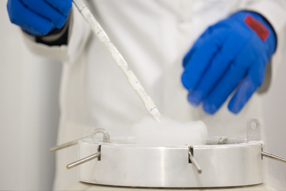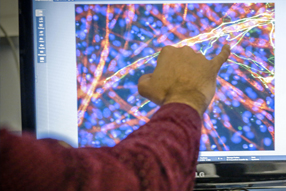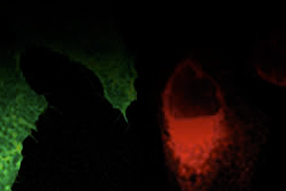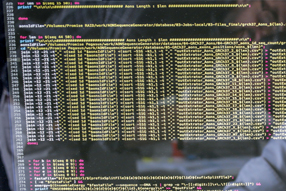Our technology platforms
Platforms welcoming external users
This platform has been created at mid-2016 by the fusion of an existing transcriptomic platform and new equipment dedicated to Next Generation Sequencing. The missions of this core facility are to provide access to genomics to transcriptomics and epigenomics sequencing and analysis services to the research teams of the Research Unit, as well, in the near future, to projects external to our Research Unit. The aim of this platform is to support and boost the genomics projects developed by the research teams of the Research Unit, by providing scientific and technologic support both at the experimental design and at the analysis/interpretation steps. For this reason, two bioinformaticians dedicated to the analysis and interpretation of the generated data have been recruited. In terms of quality and certification, the platform will try to reach the highest standards, and to obtain the ISO certification.
Services
The services provided by the platform, include next generation sequencing (NGS), Sanger sequencing, qRT-PCR, CGH array and bioinformatics services. Transcriptome by DNA microarray is available, but will progressively be replaced by RNA-Seq. For NGS sequencing, the proposed services are the following:
- Genomics : whole exome, targeted exome, amplicon sequencing, any DNA-Seq technology which might be developed
- Transcriptomics : RNA-Seq (whole transcriptome or targeted transcriptome),
- Epigenomics : ChIP-Seq, High-Throughput bisulfite sequencing
- Bioinformatics: bioinformatics services will be proposed both in the experimental design and in the analysis and interpretation of the generated data. The analysis will include primary data analysis, but also, if needed, further analysis, such as variant search, CNV search or linkage analysis, depending on the researcher’s needs. The bioinformaticians from the platform will work in close connection with the Bioinformatics team (C. Béroud), in order to implement new analysis tools, which will be developed by this team.
The genomic platform is equipped with :
Next Generation Sequencing:
- One next generation sequencer NextSeq500, Illumina
- One next generation sequencer MiniSeq, Illumina
- One next generation sequencer Ion Torrent PGM (Personal Genome Machine), Life Technologies
Sanger Sequencing:
- One Applied Biosystems 3130x Capillary Sanger sequencer
Others:
- A GeneChip microarray platform (Affymetrix)
- Covaris M220 for DNA shearing:
- Bioanalyseur 2100 (Agilent Technologies)
- Nanodrop ND-1000 spectrophotometer (Thermo Scientific), QuBit fluorimeter (Invitrogen)
- LC480 real time PCR system(Roche)
- Surescan microarray scanner (Agilent)
- Biomek 3000 (Beckman) for automatization of capture, amplicon sequencing and Q-RT-PCR
iPSC (induced Pluripotent Stem Cell) represent considerable promise as a novel tool for modeling human disease and for drug discovery thanks to their capacity of self-renewal and differentiation. The MMG has imported the iPSC technology to address the physiopathology of genetic diseases, its core competency, by taking advantage of its constant collaboration with hospitals to obtain unique samples and accompanying medical records, including from patients with atypical form of diseases.
The hiPSCs facility has been founded in 2011 by B. Binetruy and F. Magdinier in order to produce hiPSCs from primary cells from patients affected with genetic diseases explored by the different teams of U910. So far, we have developed and validated hiPSCs clones for at least 8 different rare genetic diseases. Several independent hiPSCs lines are derived for a given patient. At least 10 clones are isolated and maintained for 10 passages for stabilization. To avoid inter clone variability, two clones are selected and fully characterized. In addition, we have reprogrammed non-mutated cells available to all end-users as controls.
The hiPSCs facility is now coordinated by F. Magdinier (DR2 INSERM) and involves two engineers and one technician.
The goal of the facility personnel is to perform cell reprogramming, isolation, characterization and quality control of the hiPSCs clones and form users. The facility personnel is also involved in the technological development: adaptation to new techniques of reprogramming, development of Crispr/Cas9 genome editing, optimization of differentiation protocols. The CRISPR/Cas9 technology offers the major interest to study the effects of a given mutation in a homogenous background, representing a powerful complementary approach to the study of patients-derived hiPSCs.
The hiPSCs core facility has received several grants, from Association Française contre les Myopathies (AFM), Fondation pour la Recherche Médicale (FRM) and Fondation Aix Marseille University. The hiPSCs is associated to several research programs led by members of our research unit (AFM, ANR, A*Midex…) and has recently received a label from Aix Marseille University.
The goal is to open the facility to external users: training, on-demand reprogramming to external users (academics, Industry), production of differentiated cells for disease modeling, drug screening, etc.
The rarity of the different syndromes, the close connection with clinicians and center for biological resources and our capacity to handle hiPSCs production, characterization, differentiation and end-user training greatly facilitate the development of in vitro cellular models of rare disease, in particular for the exploration of tissues which are not otherwise accessible. This unique situation gathering clinical management of patients and technological tools availability, led us to set a new facility to make our knowhow available to collaborative laboratories. This structure will render the access to reprogramming technique much easier for scientific community. Our overall goal is to benefit patients and open new perspectives for the exploration of patho-mechanisms of these different diseases, identification of biomarkers and development of therapeutic strategies.
Platforms dedicated to MMG teams only
The mission of the Imaging core facility (ICF) applied to the exploration of small animal is to enable research teams of the MMG to access the most advanced imaging technologies. It contributes to the histological exploration of patient cells as well as animal models and to better understand the rare genetic diseases. The use of equipment is carried out by a common system of online booking.
Currently, the core facility is equipped of a confocal laser scanning microscope (ZEISS LSM800), a digital slide scanner (ZEISS Axio Scan.Z1), a live imaging microscope (ZEISS Observer Z1 and a high speed camera), an ApoTome microscope, a fluorescent binocular microscope ZEISS Axiozoom VM16) and several epifluorescent microscopes (straight or reverse Leica or ZEISS). The preparation of tissues can also be done using cryostat, vibratome or microtome. All users are trained to use the equipment and no prior imaging experience is necessary.
The Animal Phenotyping Core (APC) is a platform developed to maintain and study animal models of genetic disorders. Animal models include zebrafish and mice. We provide investigators with state-of-theart equipment for the identification and the study of mouse models of human diseases. The core establishes also protocols for the phenotyping of particular models through a functional exploration. Promotion of educational opportunities for PhD students and post-docs researchers is also our mission.
The conventional mouse facility
The conventional mouse facility is located at the Faculty of Medicine and it is registered by the “Prefecture des Bouches du Rhône” under the number B13 013 08. The Animal House Facility occupies a 250-square-meter space dedicated to enhance research on mice. This area has been designed with a separation between the housing and the functional experimentation. There is also a washing area equipped to wash the cages, the grids and the water tanks. The environment and luminous are controlled to respect the protection and the life of the animal.
There is a laboratory that is fully equipped to meet the demands of researchers wishing to test animal behaviour (Morris water maze, open field, CatWalk (gait analysis system), T-maze system, viewpoint…), and other physiological parameters (grip strength test, Plethysmograph, phenorack…).
The Fish Facility Platform
Zebrafish have been widely used as a model system for studying developmental processes, but in the last decade, they have also emerged as a valuable system for modeling human disease. Thus, our research unit has opened a novel facility to provide access to this model. The Fish Facility Platform houses, breeds and maintains fish used as biological models, with the rigorous health and welfare standards essential for genetic research. Users are trained in standard operating procedures and techniques.
All scientific procedures on animals are carrying out with respect of the European directive 2010/63/EU and the national decree n°213-118. Therefore, all users receive initial and continuous formations for designing and carrying out procedures on animals. The manager of the facilities makes monitoring of the competence. According to the national decree n°1177-2011, the use of genetically modified organisms is regulated. Each use and modification of mouse or zebrafish line is declared to the French Ministry of Higher Education and Research to obtain approval.
The Biological resources center, also part of the Department of Medical Genetics & Cell Biology, processes and maintains biological resources from patients with rare genetic diseases and their families. This structure is part of the Network of Biological Resource Centers (CRB) in Marseille and has proved to be an absolutely indispensable tool to develop the various research themes of the research unit (UMR). In the context of a novel laboratory, this CRB will be among the dedicated integrated platforms. This structure is almost entirely dedicated to process, manage and store human samples. It has in charge the DNA extractions from blood samples, generation of white cells from peripheral blood (PBMC), immortalization as lymphoblastoid cell lines (using EBV), management of the collections storage and cession of materials to researchers and/or hospital biologists. In addition, culture of fresh fibroblasts from patients is among its missions and tasks.
To date, more than 25 000 patients samples have been processed and secured. Around 50% of these samples correspond to labelled collections for research purposes, i.e to perfectly characterized patients at the clinical level. Particular collections have been set up for neuromuscular disorders, heart disorders, premature aging syndromes and central nervous system, in the main scope of our research lab.
This structure is certified by Inserm and AP-HM
CRB authorisation number by the French ministry of research: AC 2011-1312
Authorization to export and import samples : N°IE-2013-710
In the last years, we established a new organization including a Management Committee, a Strategic committee which defines the policy, strategy, communication and QMS, and a Scientific Committee which assesses new projects, assesses sample requests and write scientific reports.
Our Institutions have recognized the importance of this CRB as it is open to all AP-HM and university teams working in the field or having needs in the field of genetics and rare diseases with a view to:
- developing translational research;
- to valorize the AP-HM resources outside the institution;
- to increase partnerships with private bodies (start ups, pharmas).
Our efforts, therefore, will go towards better interactions with the institution's media services to recruit and train dedicated staff, to obtain the necessary equipment and to have suitable spaces for implementing our activities. This implementation will be done in interaction with the GIPTIS project of which the CRB will be core component, serving all projects and teams. The scientific and strategic committees are drawing-up a list of thematic research priorities to be addressed to the institutions with the of obtaining the funding necessary for the creation of new sample collections. This project is part of the medical Project for our hospital (AP-HM).



